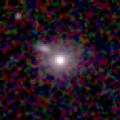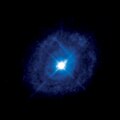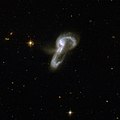Markarian Galaxy

A Markarian galaxy is a galaxy with an unusually blue color index that does not match the morphological type of the galaxy. Such galaxies were cataloged by Benjamin Markarjan and coworkers at the Bjurakan Observatory .
Morphologies
Markarian galaxies include almost all morphological types of galaxies. A comparison with other catalogs shows a large proportion of peculiar galaxies among the Markarian galaxies, which are mainly classified as compact (post) eruptive galaxies or as interacting galaxies . There is no connection between the morphological type and the degree of UV excess.
Position in galaxy clusters
Markarian galaxies occur almost exclusively in galaxy clusters . Less than two percent are single galaxies surrounded only by satellite systems. The Markarian galaxies do not have a special position within galaxy clusters.
Activity of the nucleus
The vast majority of Markarian galaxies belong to those galaxies with an active galactic core . The galaxies with an active core are statistically significantly more frequently interacting galaxies.
In addition still belong starburst galaxies and former starburst galaxies with large HII regions of the Markarian galaxies. In these, a connection between the excess UV and the star formation rate was observed.
gallery
literature
- VE Karachentseva, OV Melnyk, ID Karachentsev: Star formation rates in nearby Markarian galaxies . In: Astrophysics. Solar and Stellar Astrophysics . 2014, arxiv : 1403.1066v1 .
- TA Nazaryan, AR Petrosian, AA Hakobyan, BJ McLean, D. Kunth: Close neighbors of Markarian galaxies. II. Statistics and discussions . In: Astrophysics. Solar and Stellar Astrophysics . 2014, arxiv : 1310.0241v1 .
- TA Nazaryan, AR Petrosian, BJ McLean: Close neighbors of Markarian galaxies. I. Optical database . In: Astrophysics. Solar and Stellar Astrophysics . 2012, arxiv : 1211.3970v1 .










